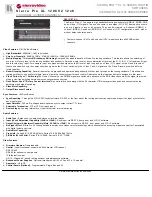
Chapter 32 OSPF
XGS-4728F User’s Guide
274
The following table describes the four classes of OSPF routers.
The following figure depicts an OSPF network example. The backbone is area 0
with a backbone router. The internal routers are in area 1 and 2. The area border
routers connect area 1 and 2 to the backbone.
Figure 146
OSPF Network Example
32.1.2 How OSPF Works
Layer 3 devices exchange routing information to build a synchronized link state
database within the same AS or area. The link state database contains records of
router IDs, their associated links and path costs. Each device can then use the link
state database and Dijkstra algorithm to compute the least cost paths to network
destinations.
Layer 3 devices build a synchronized link state database by exchanging Hello
messages to confirm which neighbor (layer 3) devices exist and then they
exchange database descriptions (DDs) to create the link state database. The link
state database is constantly updated through LSAs (Link State Advertisements).
32.1.3 Interfaces and Virtual Links
An OSPF interface is a link between a layer 3 device and an OSPF network. An
interface has state information, an IP address and subnet mask associated with it.
Table 95
OSPF: Router Types
TYPE
DESCRIPTION
Internal Router (IR)
An Internal or intra-area router is a router in an area.
Area Border Router
(ABR)
An Area Border Router connects two or more areas.
Backbone Router (BR)
A backbone router has an interface to the backbone.
AS Boundary Router
An AS boundary router exchanges routing information with
routers in other ASs.
Summary of Contents for XGS-4728F
Page 2: ......
Page 8: ...Safety Warnings XGS 4728F User s Guide 8 ...
Page 24: ...24 ...
Page 30: ...Chapter 1 Getting to Know Your Switch XGS 4728F User s Guide 30 ...
Page 34: ...Chapter 2 Hardware Installation and Connection XGS 4728F User s Guide 34 ...
Page 42: ...Chapter 3 Hardware Overview XGS 4728F User s Guide 42 ...
Page 44: ...44 ...
Page 78: ...Chapter 7 System Status and Port Statistics XGS 4728F User s Guide 78 ...
Page 92: ...Chapter 8 Basic Setting XGS 4728F User s Guide 92 ...
Page 94: ...94 ...
Page 114: ...Chapter 9 VLAN XGS 4728F User s Guide 114 ...
Page 118: ...Chapter 10 Static MAC Forward Setup XGS 4728F User s Guide 118 ...
Page 148: ...Chapter 14 Bandwidth Control XGS 4728F User s Guide 148 ...
Page 162: ...Chapter 17 Link Aggregation XGS 4728F User s Guide 162 ...
Page 186: ...Chapter 21 Policy Rule XGS 4728F User s Guide 186 ...
Page 230: ...Chapter 25 AAA XGS 4728F User s Guide 230 ...
Page 268: ...268 ...
Page 324: ...324 ...
Page 332: ...Chapter 38 Maintenance XGS 4728F User s Guide 332 ...
Page 358: ...Chapter 41 Syslog XGS 4728F User s Guide 358 ...
Page 366: ...Chapter 42 Cluster Management XGS 4728F User s Guide 366 ...
Page 370: ...Chapter 43 MAC Table XGS 4728F User s Guide 370 ...
Page 374: ...Chapter 44 IP Table XGS 4728F User s Guide 374 ...
Page 378: ...Chapter 46 Routing Table XGS 4728F User s Guide 378 ...
Page 382: ...382 ...
Page 392: ...Chapter 48 Troubleshooting XGS 4728F User s Guide 392 ...
Page 402: ...Chapter 49 Product Specifications XGS 4728F User s Guide 402 ...
Page 404: ...404 ...
Page 408: ...Appendix A Legal Information XGS 4728F User s Guide 408 ...
















































